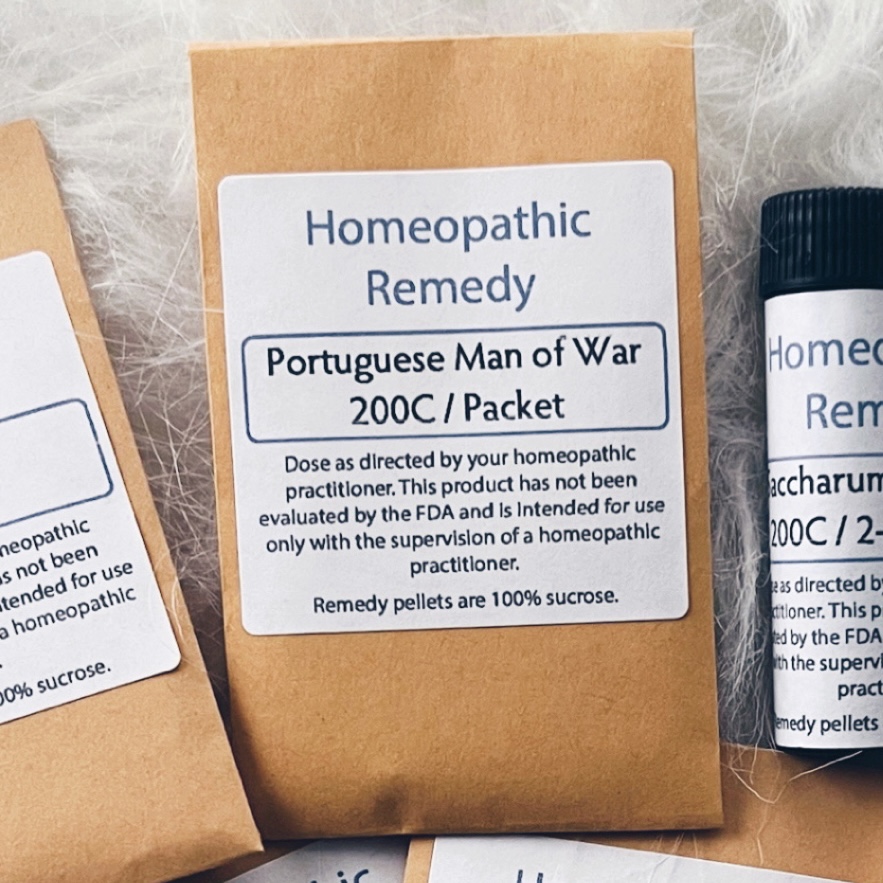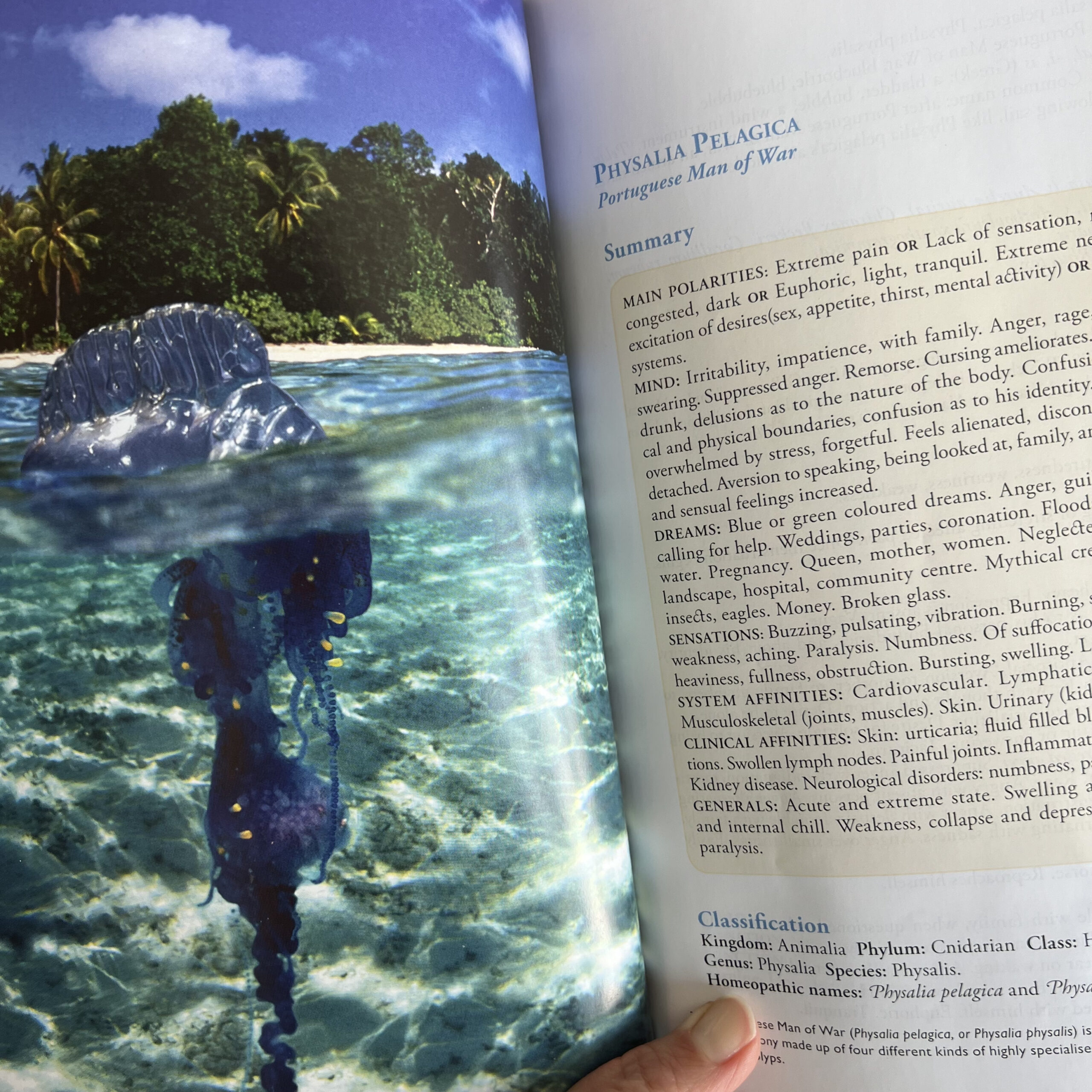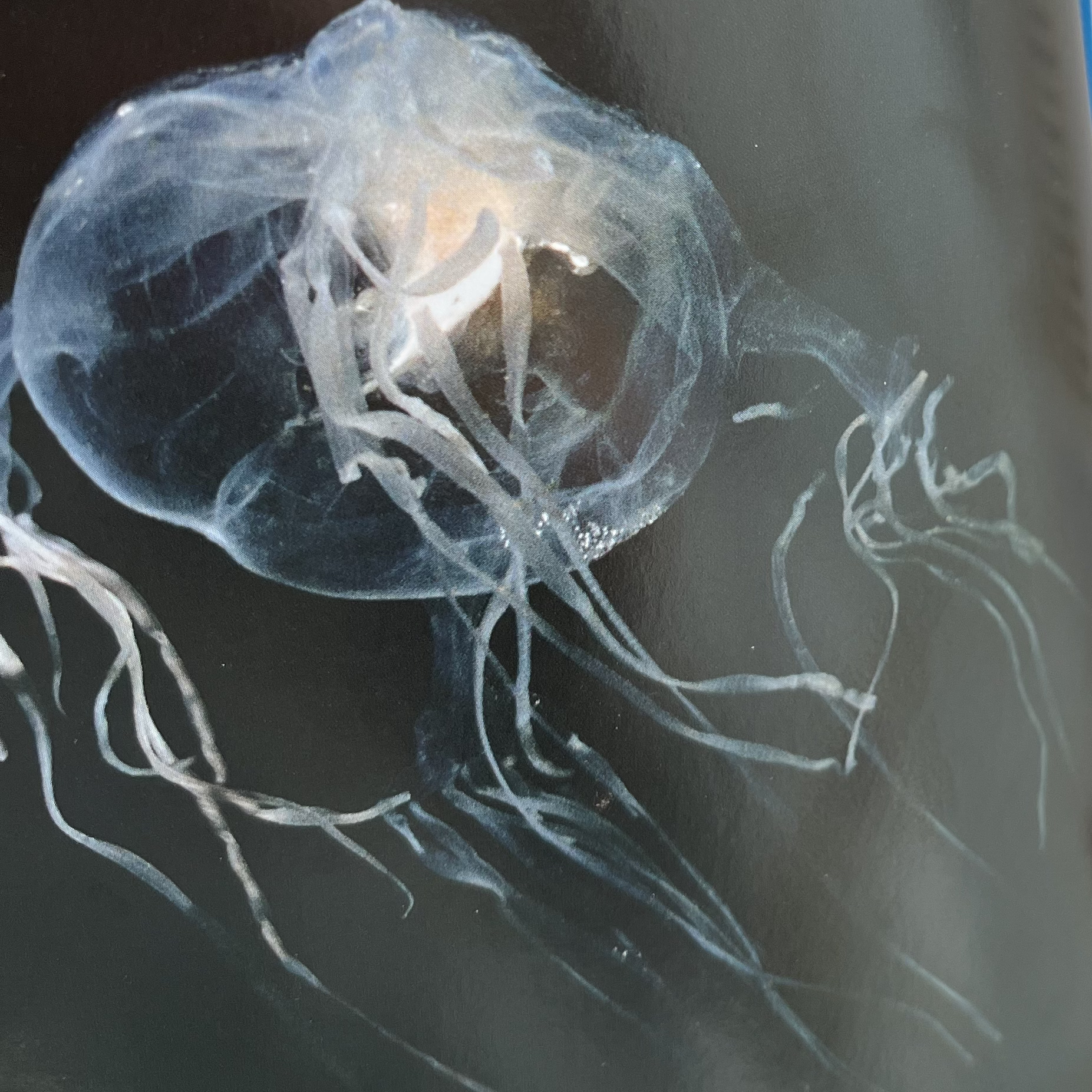A Portuguese Man of War stung my shin two weeks ago. I was swimming in the ocean with my family, and we’d seen a number of them washed up on the beach. Not long before it happened, my husband mentioned seeing one floating in the water near us. I didn’t think much of it, until that sting.
You really get to know a homeopathic remedy (and its healing potential) when you experience the toxic effects of its source.
I felt a pinpoint shock like an intense bee sting that nearly brought me to my knees in the water. But unlike my experience of bee stings, the pain intensified exponentially after the sting. It went from burning and stinging pain at the site to a tearing pain that rose, cramp-like, up my leg and into my hip.
Never having been stung by a Man of War, I felt a bit nervous. I’d not studied Physalia Pelagica (the remedy made from the Portuguese Man of War), so I didn’t know that muscle spasm could be expected from the venom, in addition to the red, painful welts.
After checking in with the lifeguard to calm my nerves, I turned to the remedies I had on hand that most closely matched my symptoms and the causation (Apis and Ledum). But I would have appreciated a dose of Physalia that day. I’ve since studied and ordered the remedy, of course. By the way, I also took Aconite for the shock.
Homeopathic sea remedies are some of my favorite in the materia medica, mostly because of my love for the sea and her creatures. Inspired by my recent encounter and my subsequent learning, I want to share a few of them with you.

Homeopathic Sea Remedies
The sea is our mother. We are born from a sea within our mother. Like our mother’s amniotic fluid, the sea protects, buoys, and holds the complexities of life. From my psych days I remember Carl Jung’s assertion of the sea as a symbol of the unconscious mind, “the mother of all that lives.” We know a fraction of what the sea and the unconscious mind hold within them. Maybe this is why I’m so fascinated by them both?
Much of what I’ve learned about sea remedies I’ve learned from the awe-inspiring book, Sea Remedies: Evolution of the Senses, by Jo Evans. It’s not just an informational text; rather, it offers metaphor and imagery that brings the remedies and the sea to life.
Evans shares three keynotes of the invertebrate sea remedies (note: her book is specifically about the invertebrates) that may guide you to their consideration:
1) a sense of alienation;
2) division between self and other; and
3) conflicts between the male and female aspects of the inner self.

I think sea remedies are particularly suited to our time on this planet. I wonder if the intensity of our felt sense of these themes right now is what leads so many of us to homeopathy?
In the remedies I share below, you will perceive aspects of some of these themes. I’ve also shared a sea remedy that is not an invertebrate (Ambra Grisea), as it reflects these themes as well.
Ambra Grisea
Ambra Grisea is made from ambergris, a waxy secretion found in the digestive tract of the sperm whale. Interestingly, it’s made up, in part, of cephalopod ink (like Sepia) and the beaks of cephalopods like cuttlefish and squid that the whale consumes. This substance protects the whale’s digestive tract from sharp things (the beaks), preventing ripping and tearing. From this you may see how Ambra Grisea has similarities to the cephalopod remedies like Sepia.
Ambra has an affinity for the limbic and nervous system, as evidenced by the memory, vagus nerve, and digestive symptoms. Some things that stand out to me about the person who needs this remedy:
- There is a deep sense of embarrassment, especially when in company or in public. She is intensely bashful and blushes easily.
- Ambra has difficulty going to the bathroom with others present or when outside of their own home. And they feel disgust or shame about their bodily functions (the odor of their own stool, for example). I’ve prescribed it for a child with severe constipation who refuses to stool in the toilet, hides to have a bowel movement, and yet is disgusted by being dirty or in his stool.
- Didier Grandgeorge shares the theme in Ambra that “people devour me.” They only feel safe inside the family and demand privacy to cope with this sensation. (The write up about Ambra Grisea in his book is worth a read). It also highlights the difficulty for some children in transitioning from the oral to anal phase (and subsequent withholding of stool).
- As with other sea remedies, there are polarities of hypersensitiveness (tearing pains) and numbness.
- She tends to dwell on unpleasant things, past events, long ago grief. It is a remedy to think of alongside Nat Mur (a mineral remedy from the sea).
I definitely suggest reading Evans’ write up about Ambra Gresia in the introduction of her book, as she explores the metaphor of the whale’s belly, among other things, which further clarifies this remedy.
Physalia Pelagica
Physalia is made from the Portuguese Man of War (a Cnidarian alongside jellyfish, anemones, and corals). As I described above, the sting of the Man of War produces intense, burning, stinging pains with violent itching (this came later for me) and red eruptions that appear like vesicles or urticaria. In severe cases there is ascending muscular weakness and paralysis. The skin symptoms may remind one of Apis, Cantharis, Urtica Urens, or Rhus Tox.
These symptoms are, however, only a few of the symptoms that homeopathic Physalia can relieve.

Physalia has an affinity for the cardiovascular, lymphatic, respiratory, nervous, and musculoskeletal systems as well as the skin and kidneys. Some things that stand out to me in this remedy:
- Like other Cnidarians there are polarities of pain and numbness and polarities of heaviness and lightness.
- Similar to Sepia (a Cephalopod), there is irritability and impatience with the family.
- Physalia has suppressed anger with indignation, ailments from anger, and generally easily angered, as well as confusion as to psychological and physical boundaries. This reminds me of themes of Staphisagria, which can be thought of for ailments from unwanted penetration (violation of boundaries)…any bite or sting may be experienced as unwanted penetration, and Staph may be helpful for a person who repeatedly suffers bites or stings of any kind.
- A sense of being overwhelmed by stress, and a feeling alienation or disconnectedness. Physalia may be averse to family and company.
- Sensations of numbness, weakness, vibration, buzzing, pulsation, constriction, stiffness, tearing (again…similar to cephalopods), shooting pains.
Chironex Fleckeri
Chironex Fleckeri is made from the deadly box jellyfish. During my homeopathic education I had a client for whom Sepia repertorized highly. She had the unique and very striking symptom of heaviness with a bruised sensation. Having never learned of the invertebrate sea remedies, I did not know (until my supervisor pointed it out) that Chironex has this symptom. It is the only remedy in the repertory under the rubric: Generals, heaviness, internally, accompanied by, bruised feeling. Chironex helped this client immensely.
Chironex has affinities for the nervous, immune, cardiovascular, gastrointestinal, and lymphatic systems.
Like Physalia, we can see what it has the power to heal by looking at the effects of its sting on a healthy individual. When stung, the venom goes straight to the heart and can kill within minutes. There is cramping, burning, and extreme pain, acceleration of respiration and heart rate along with anxiety and restlessness, perspiration and vomiting, all followed by shut down of the body. There is a suddenness in this remedy and a sluggishness.

Some things that stand out to me in this remedy:
- Like its Cnidarian sister, Physalia, and its Cephalopod cousin, Sepia, Chironex also has the sensation of heaviness. But it also has the bruised sensation/as if bones were bruised alongside it. And there is the polarity in this remedy, too. Sensations as if the body is extremely light, floating, and made of pure light oppose the heaviness.
- Like Physalia, Chironex is easily angered, and this may alternate with indifference and irritability.
- There may be difficult concentration, fogginess, forgetfulness, AND there may be clairvoyance and clarity at times.
- Again we see the theme of aversion or irritability with family, as we do in many sea remedies. Chironex specifically has an aversion to the husband.
- There are opposing sensations in the chest of heaviness/oppression with anxiety and elation/joy, “like butterflies lifting my chest and my spirits.”
Eledone Cirrhosa
The lesser octopus is, in my opinion, maybe one of the most underused remedies for women with menopausal symptoms.
Like Sepia, which is well known, well proven, and often used in menopause (thus not featured in this blog), Eledone is a cephalopod. And Cephalopods have some things in common…
- Ambitiousness along with a feeling of being impeded (in work, social position, relationships). A sense of struggling against an opposing force.
- So, there may be great passion & intensity OR they may be completely burned out.
- Dreams of floating, flying, falling, being pulled backwards or downwards, being held back and bursting out.
- Polarities of high energy/hurry and heaviness or stuckness.
- Camouflaging oneself, or concern over appearance on the one hand, and in the burned out state, neglecting it (which may also serve to camouflage).
- Themes of deception and hiding or directness and truth telling, revealing what is hidden.
- Passionate: there may be strong aversions to opposite sex; very high or very low sex drive.
- Great anxiety over children or irritability towards them, dreams of children in danger.
- Sensations of rupture, tearing, bearing down, heaviness, prolapse, obstruction, pressure, stitching, stabbing, heat, bursting.
When Sepia is indicated for a woman in peri/menopause, it’s wise to consider Eledone Cirrhosa, too. Note how they differ…
From Jo Evans’ Sea Remedies: Evolution of the Senses:
“The octopus is known to have the more complex brain and they stay hidden in their lairs during the day. Cuttlefish (Sepia) are not known to be fastidious, while the octopus will renovate lairs and clear away debris, leaving neat little piles outside. The octopus hunts relatively inactive prey, such as crabs and more sedentary mollusks, whereas cuttlefish move faster and hunt swimming crustaceans and even fish.”
Symptoms
Flushing and heart palpitations are some of the most prominent symptoms in this remedy.
Other symptoms include:
- Inflammation of sinuses with right-sided headache
- Face pain, extending to ears; noises in the ears (hissing, rushing, swooshing)
- Constipation
- Urge to urinate at night (cystitis)
- Ovarian pain
- Sensation of a lump on swallowing
- Anxiety in chest
- Foot cramps at night
- Trembling from emotional causes
*Book photos were taken from Jo Evans’ book.


